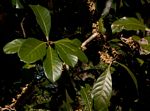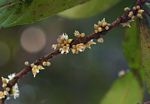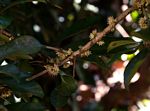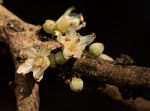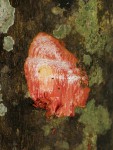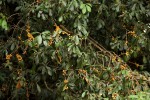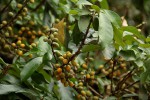Synsepalum brevipes
Selected images: Click on each image to see a larger version and details of the record View all images (16)
Detailed records: Display species records QDS maps by: Google Maps Point records by Google Maps
Species details: Click on each item to see an explanation of that item (Note: opens a new window)
| Synonyms: |
Chrysophyllum cinereum Engl. Chrysophyllum stuhlmannii Engl. Pachystela brevipes Baker) Engl. Pachystela cinerea (Engl.) Engl. Pouteria brevipes (Baker) Baehni Sideroxylon brevipes Baker |
| Common names: | Stem-fruit miraculous-berry (English) |
| Frequency: | |
| Status: | Native |
| Description: |
Shrub or small to medium-sized tree. Bark grey-brown to blackish, rough in older specimens; stem often fluted; milky latex present. Leaves oblanceolate to narrowly obovate, 9-25 cm long, leathery, glossy green and hairless above, pale with silvery hairs and distinct, parallel lateral veins below, midrib grooved. Young leaves and twigs covered in short brown hairs. Flowers in few to many-flowered clusters on dwarf spur branchlets along the branches, greenish to creamy-white, sweetly scented. Fruit thinly fleshy, ellipsoid, c. 2.5 × 1.5 cm, yellow to orange when ripe, tipped by the style and cupped in the calyx lobes, edible. |
| Type location: |
Syntypes from Tanzania and Malawi |
| Notes: | |
| Derivation of specific name: | |
| Habitat: | In riverine forest and dry evergreen forest on the fringes of lakes. |
| Altitude range: (metres) | |
| Flowering time: | Jan - May |
| Worldwide distribution: | Widespread in tropical Africa to Mozambique and Zimbabwe. |
| FZ divisions: | N,Z,MS |
| Growth form(s): | |
| Endemic status: | |
| Red data list status: | |
| Insects associated with this species: | |
| Spot characters: | Display spot characters for this species |
| Images last updated: | Wednesday 16 March 2016 |
| Literature: |
Burrows, J.E., Burrows, S.M., Lötter, M.C. & Schmidt, E. (2018). Trees and Shrubs Mozambique Publishing Print Matters (Pty), Cape Town. Page 743. (Includes a picture). Chapano, C. & Mamuto, M. (2003). Plants of the Chimanimani District National Herbarium and Botanic Garden, Zimbabwe Page 54. Coates Palgrave, K. (revised and updated by Meg Coates Palgrave) (2002). Trees of Southern Africa 3rd edition. Struik, South Africa Pages 872 - 873. Da Silva, M.C., Izidine, S. & Amude, A.B. (2004). A preliminary checklist of the vascular plants of Mozambique. Southern African Botanical Diversity Network Report No. 30 Sabonet, Pretoria Page 109. Drummond, R.B. (1975). A list of trees, shrubs and woody climbers indigenous or naturalised in Rhodesia. Kirkia 10(1) Page 266. As Pachystela brevipes Kupicha, F.K. (1983). Sapotaceae Flora Zambesiaca 7(1) Pages 225 - 227. as Pachystela brevipes (Includes a picture). Mapaura, A. & Timberlake, J. (eds) (2004). A checklist of Zimbabwean vascular plants Southern African Botanical Diversity Network Report No. 33 Sabonet, Pretoria and Harare Page 77. Meerts, P. & Hasson, M. (2016). Arbres et arbustes du Haut-Katanga Jardin Botanique Meise, Belgique Page 122. (Includes a picture). Ntore, S. & al. (2024). Checklist of the vascular plants of Burundi Page 233. Phiri, P.S.M. (2005). A Checklist of Zambian Vascular Plants Southern African Botanical Diversity Network Report No. 32 Page 96. Strugnell, A.M. (2006). A Checklist of the Spermatophytes of Mount Mulanje, Malawi Scripta Botanica Belgica 34 National Botanic Garden of Belgium Page 175. Timberlake, J.R., Bayliss, J., Dowsett-Lemaire, F., Congdon, C., Branch, B., Collins, S., Curran, M., Dowsett, R,J., Fishpool, L., Francisco, J., Harris, Kopp, M. & de Sousa, C. (2012). Mt Mabu, Mozambique: Biodiversity and Conservation Report produced under the Darwin Initiative Award 15/036. Royal Botanic Gardens, Kew, London Page 75. White, F., Dowsett-Lemaire, F. & Chapman, J.D. (2001). Evergreen forest flora of Malawi Royal Botanic Gardens, Kew Pages 543 - 546. (Includes a picture). |
Other sources of information about Synsepalum brevipes:
Our websites:
Flora of Burundi: Synsepalum brevipesFlora of the DRC: Synsepalum brevipes
Flora of Malawi: Synsepalum brevipes
Flora of Zambia: Synsepalum brevipes
Flora of Zimbabwe: Synsepalum brevipes
External websites:
African Plants: A Photo Guide (Senckenberg): Synsepalum brevipesAfrican Plant Database: Synsepalum brevipes
BHL (Biodiversity Heritage Library): Synsepalum brevipes
EOL (Encyclopedia of Life): Synsepalum brevipes
GBIF (Global Biodiversity Information Facility): Synsepalum brevipes
Google: Web - Images - Scholar
iNaturalist: Synsepalum brevipes
IPNI (International Plant Names Index): Synsepalum brevipes
JSTOR Plant Science: Synsepalum brevipes
Mansfeld World Database of Agricultural and Horticultural Crops: Synsepalum brevipes
Plants of the World Online: Synsepalum brevipes
Tropicos: Synsepalum brevipes
Wikipedia: Synsepalum brevipes
